The world of Linux operating systems welcomes AnduinOS, a Debian-based distribution designed to offer an accessible, functional, and familiar experience for users, especially those coming from Windows environments. AnduinOS 1.0 was officially released on September 1, 2024, after months of intensive development and thorough testing.
The Origin of AnduinOS: From a Script to a Full Distribution
AnduinOS originated as a simple idea: a script to efficiently initialize Windows systems. Over time, this concept evolved into creating custom configurations on Linux and ultimately into a complete operating system. Inspired by distributions like Arch Linux and NixOS, the project’s creator embarked on the challenge of building a distribution from scratch, combining Debian tools and elements from Ubuntu to take advantage of the stability and popularity of its package ecosystem.
Unlike other distributions, AnduinOS prioritizes a simplified approach to installation and daily use. Its design aims to offer a balance between the flexibility of Linux and the familiarity of Windows, making the transition easier for new users.
A Simplified Installation Process
One of the main features of AnduinOS is its installer. Inspired by the ease of installation of Windows, the installer uses a decompression method similar to Windows WIM files. The base system, pre-configured and packed into a single squashfs file, is directly decompressed onto the disk during the installation process. This allows for a fast and efficient installation, avoiding the complicated manual steps often necessary in other distributions.
The installer guides the user through the initial setup, such as language selection, time zone, passwords, and partitions, significantly reducing the learning curve.
Windows-Inspired Design and Functionality
The interface design of AnduinOS intentionally resembles that of Windows 11. With a focus on ergonomics and usability, the system uses GNOME as its foundation, modified with numerous patches to replicate key elements of Windows design. This includes a always-visible taskbar, quick access to important settings, and the absence of upper panels, which simplifies navigation and closing applications.
The goal is to provide an intuitive experience that combines the best of both worlds: the power and flexibility of Linux with the familiarity of Windows.
A Minimal but Effective Application Store
Although AnduinOS doesn’t yet have a fully functional application store, it offers a web index with installation methods for various programs. This allows users to choose from multiple package managers, such as Snap, Flatpak, AppImage, and Apt, depending on their preferences. This decision reflects a pragmatic approach: allowing users to manage their applications in whatever way they find most convenient, rather than imposing a single installation method.
Technical Features and Underlying Architecture
AnduinOS is based on the principles of modularity and efficiency. Some notable technical aspects include:
- Built on Debian and compatible with Ubuntu: Leverages Debian’s stability and Ubuntu’s extensive package base, ensuring a robust and up-to-date ecosystem.
- Modular architecture: Allows individual system components to be replaced or updated without restarting, minimizing downtime.
- Automated installation: Uses chroot tools and customized scripts to efficiently build the system from scratch.
- Compatibility with common hardware: Support for Intel, AMD, and ARM architectures, along with standard peripherals like keyboards, mice, and basic graphics cards.
Challenges and Lessons in Development
The development process of AnduinOS was not without challenges. From designing a functional installer to ensuring compatibility with hardware and software, the team faced numerous technical hurdles. One of the biggest lessons learned was understanding the inherent complexity of creating an operating system and how seemingly simple solutions, like using squashfs, can create new complications that require creativity to resolve.
Moreover, the focus on user experience led to key decisions, such as integrating visual tools and designing inspired by popular systems, to ensure that AnduinOS is accessible to a broad audience.
A Project in Constant Evolution
Although AnduinOS 1.0 is now available and usable for daily tasks, development continues. Future versions plan to include improvements to the application store, increased support for Secure Boot, and performance optimization on older hardware. The team behind AnduinOS also seeks to expand its community of users and contributors, inviting everyone interested to test, contribute, and shape the future of this promising distribution.
AnduinOS is not just an operating system; it’s a new way to approach the world of Linux, with an accessible design, modern functionality, and a focus on simplicity aimed at democratizing access to technological tools.

